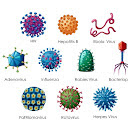Viral Classification
Virus and it's classification
The term virus is a word that has become synonymous with the COVID-19 pandemic, but viruses have been around for much longer than that. Viruses are infectious agents that are incredibly small, consisting of genetic material enclosed in a protein coat or capsid. They are not living organisms but can only replicate inside the living cells of other organisms. In this 1000-word SEO article, we will explore what viruses are, how they work, and the different types of viruses that exist.
Pic: Viral Classification.PHOTO Credit: freepik.Table of Contents
What is a Virus?
A virus is a microscopic infectious agent that consists of genetic material, either DNA or RNA, and a protein coat or capsid that protects the genetic material. Some viruses also have an outer envelope made of lipids. Viruses cannot replicate on their own but must infect a living cell to do so. They attach themselves to a host cell and inject their genetic material into it. Once inside the cell, the virus takes over the cell's machinery and uses it to produce more virus particles. These particles are then released from the host cell, which can then infect other cells and continue the cycle.
How do Viruses Spread?
Viruses can spread through various means, including:Direct contact:
This occurs when an infected person touches or exchanges body fluids with another person.Indirect contact:
This occurs when a person touches a surface contaminated with the virus and then touches their eyes, nose, or mouth.Airborne transmission:
This occurs when a virus is released into the air through coughing or sneezing and is inhaled by another person.Vector-borne transmission:
This occurs when a virus is transmitted to humans through an insect or animal vector, such as a mosquito or tick.Types of Viruses
There are many different types of viruses that can infect humans, animals, and plants. Some of the most well-known types of viruses include:Influenza Virus:
This virus causes the flu, a respiratory illness that can range from mild to severe.Human Immunodeficiency Virus (HIV):
This virus attacks the immune system and can lead to acquired immunodeficiency syndrome (AIDS).Hepatitis Virus:
There are several types of hepatitis viruses, which can cause inflammation of the liver.Herpes Virus:
There are several types of herpes viruses, which can cause cold sores, genital herpes, and other infections.Coronavirus:
This virus caused the COVID-19 pandemic and can cause respiratory illness ranging from mild to severe.Ebola Virus:
This virus causes Ebola virus disease, which is a severe and often fatal illness.Rabies Virus:
This virus is transmitted to humans through the saliva of infected animals and can cause a fatal brain infection if left untreated.Preventing Viral Infections
Preventing viral infections is crucial for staying healthy and avoiding the spread of disease. There are several ways to prevent viral infections, including:- Vaccination: Vaccines are an effective way to prevent viral infections by stimulating the immune system to produce antibodies against the virus.
- Hand hygiene: Washing hands regularly with soap and water or using an alcohol-based hand sanitizer can help to reduce the spread of viruses.
- Wearing masks: Masks can prevent the spread of respiratory viruses, such as COVID-19, by trapping droplets from coughs and sneezes.
- Social distancing: Maintaining a distance of at least 6 feet from others can help to reduce the spread of viruses. Avoiding large gatherings: Large gatherings can increase the spread of viruses, so it is best to avoid them if possible.


Comments
Post a Comment